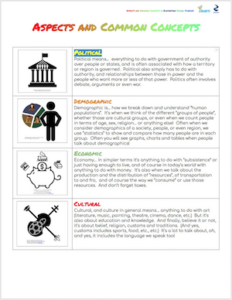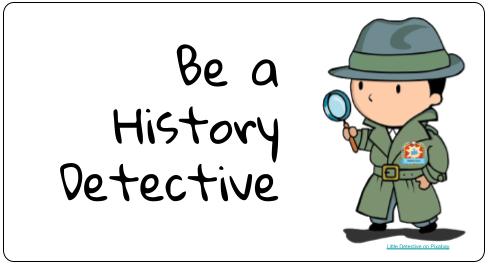
Exploring history, geography and citizenship is a bit like being a detective. It often starts by observing things in your environment. You can try to figure out why things are the way they are now. It’s like trying to solve a mystery.
You might want to investigate:
- Who lives or has lived on a specific territoryA territory is an area of land, or sometimes of sea, that we can say “belongs”…? How did they come to live there? What did life on the territoryA territory is an area of land, or sometimes of sea, that we can say “belongs”… look like during a specific period in time?
- What is the territoryA territory is an area of land, or sometimes of sea, that we can say “belongs”… used for now? How has it been used in the past? Who used it?
- What are places in my area named after? Who came up with these names? What is the significance of these names?
- What are the roles different people have on the territoryA territory is an area of land, or sometimes of sea, that we can say “belongs”… today? How have these roles changed over time? Are the roles people have similar and different across societies?
- What is an object used for? Who invented it? When was it invented?
We have gathered information to help you become a great history detective. Keep reading to learn tips on how to investigate and understand societies!
The Intellectual Operations:
Once you’ve figured out what you will investigate, you need to begin establishing facts using documents. This is why Establish Facts is one of the main Intellectual Operations (or IO’s for short!). IO’s are things you can “do” with your knowledge and documents. In Elementary, there are 8 IO’s. Below, you will find links to infographics to help you learn more about each of the IO’s. Want to practice a specific IO? Here is a link to a Google Folder containing IO Badge Guides to get you started!
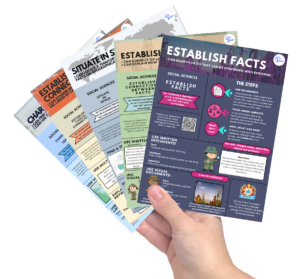 Click here to access all 8 IO infographics in full color!
Click here to access all 8 IO infographics in full color!
Click here to access printer-friendly versions of the same IO infographics!
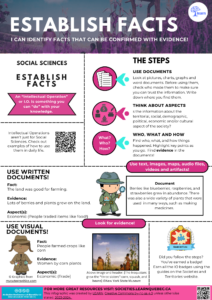
Using Diverse Documents:
Just like a real detective, you need to establish facts from many different sources and backup your facts with evidence. You can use videos, books, images, artifacts, and more. Getting all your information about a society or a territoryA territory is an area of land, or sometimes of sea, that we can say “belongs”… from one document is kind of like only interviewing one person about a crime; you may miss a lot of important information! To get to the real truth, you need more than one source!
Below is an infographic that shows some of the different kinds of documents you can use.
Click here to a PDF of the infographic in full color.
Click here to access printer-friendly version of the same infographic!
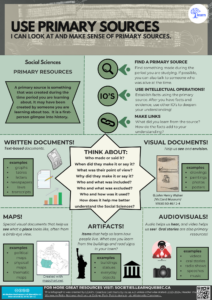
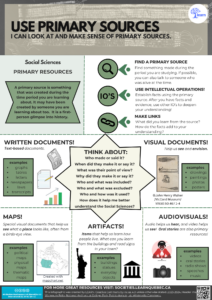
It is usually best to use primary documents or sources. Primary documents are things that were created during the time you are studying. It is good to use resourcesResources are anything taken from the earth or nature that people need, use, and are “valued”…. made by the society you are learning about or documents made by people from different societies or social groups. While your class textbook provides a good overview, viewing other documents will help you check for biases: opinions about events or people that might not be fair or accurate. It is always important to think critically about who created a document and why.
When working with documents, it is also helpful to highlight or underline important information like the 5W’s: Who, What, When, Where, and Why (and sometimes How). This information can help you use the IO’s!
Finally, just like a real detective, you should record your sources incase you, or someone else, needs to recheck them. You should also make sure they are reliable or trustworthy. Here is a short MediaSmarts video with tips to help you fact-check documents
The Aspects:
It can helpful to group information by aspect so you can more easily interpret changes over time or similarities and differences between societies and territories. You can learn about the aspects of society using this linked document.
You may also want to use these Competency Synthesis Placemats to record facts about aspects of the societies you are learning about. Try using words like demographics and politics to describe aspect of a society; it makes you sound like professional historians!
Check your Aspects knowledge:
The Competencies:
You will get one mark for Social Sciences on your report card, but your teacher is actually looking for three different competencies. It’s helpful to learn about these competencies so you know what your teacher wants you to do.
- Competency 1 has to do with understanding how one society is organized on a territoryA territory is an area of land, or sometimes of sea, that we can say “belongs”….
- Competency 2 has to do with how one society changes over time.
- Competency 3 has to do with how two societies that existed at the same time (but not necessarily in the same place) are similar and different.
Check your Competency knowledge:
